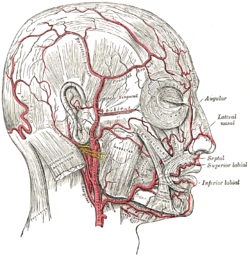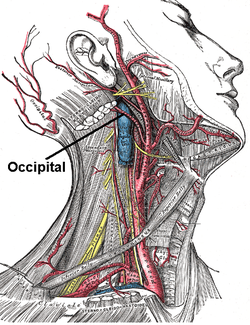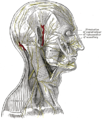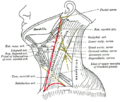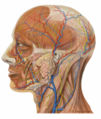- Occipital artery
-
Artery: Occipital artery The arteries of the face and scalp. (Occipital visible at center left.) Superficial dissection of the right side of the neck, showing the carotid and subclavian arteries. Latin arteria occipitalis Gray's subject #144 556 Supplies occiput, scalp Source external carotid artery Vein occipital vein The occipital artery arises from the external carotid artery opposite the facial artery, its path is below the posterior belly of digastric to the occipital region. This artery supplies blood to the back of the scalp and sterno-mastoid muscles. Other muscles it supplies are deep muscles in the back and neck.
Contents
Course and Relations
At its origin, it is covered by the posterior belly of the Digastricus and the Stylohyoideus, and the hypoglossal nerve winds around it from behind forward; higher up, it crosses the internal carotid artery, the internal jugular vein, and the vagus and accessory nerves.
It next ascends to the interval between the transverse process of the atlas and the mastoid process of the temporal bone, and passes horizontally backward, grooving the surface of the latter bone, being covered by the Sternocleidomastoideus, Splenius capitis, Longissimus capitis, and Digastricus, and resting upon the Rectus capitis lateralis, the Obliquus superior, and Semispinalis capitis.
It then changes its course and runs vertically upward, pierces the fascia connecting the cranial attachment of the Trapezius with the Sternocleidomastoideus, and ascends in a tortuous course in the superficial fascia of the scalp, where it divides into numerous branches, which reach as high as the vertex of the skull and anastomose with the posterior auricular and superficial temporal arteries.
Branches
- Sternocleidomastoid branches : They are 2 in number and are given off in the Carotid triangle. The upper branch accompanies the accessory nerve, and the lower branch arises near the origin of the occipital artery.
- Auricular branch
- Mastoid branch
- Descending branches
- Occipital branches
Its terminal portion is accompanied by the greater occipital nerve.
Additional images
External links
- Occipital+artery at eMedicine Dictionary
- Anatomy at MUN head/cbv
- lesson4 at The Anatomy Lesson by Wesley Norman (Georgetown University) (parotid4)
- Diagram at stchas.edu
- Description at okstate.edu
- http://www.dartmouth.edu/~humananatomy/figures/chapter_47/47-2.HTM
This article was originally based on an entry from a public domain edition of Gray's Anatomy. As such, some of the information contained within it may be outdated.
List of arteries of head and neck (TA A12.2.05–08, GA 6.549) CC cervical branches (ascending palatine, tonsillar, submental, glandular) · facial branches (inferior labial, superior labial / nasal septum, lateral nasal, angular)occipital1st part / mandibular2nd part / pterygoid3rd part / pterygopalatineorbital group:anterior ethmoidal (anterior septal, anterior lateral nasal, anterior meningeal) · posterior ethmoidal · lacrimal (lateral palpebral) · medial palpebral · terminal (supraorbital, supratrochlear, dorsal nasal)
ocular group: central retinal · ciliary (short posterior, long posterior, anterior) · hypophysial (superior, inferior)ACA (anterior communicating, medial striate) · MCA (anterolateral central, Orbitofrontal artery, Prefrontal artery, Superior terminal branch, Inferior terminal branch, Anterior temporal branch) · posterior communicating · anterior choroidalSC Categories:- Cardiovascular system stubs
- Arteries of the head and neck
Wikimedia Foundation. 2010.

